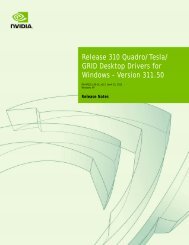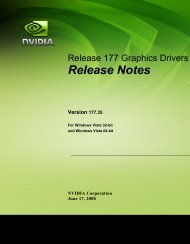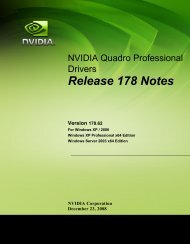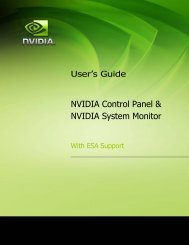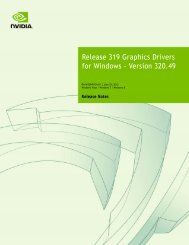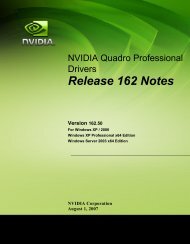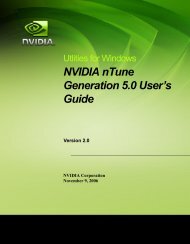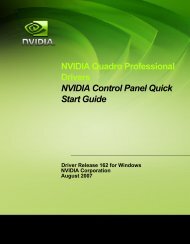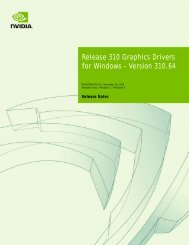NVIDIA Quadro Professional Drivers NVIDIA Control Panel Quick ...
NVIDIA Quadro Professional Drivers NVIDIA Control Panel Quick ...
NVIDIA Quadro Professional Drivers NVIDIA Control Panel Quick ...
You also want an ePaper? Increase the reach of your titles
YUMPU automatically turns print PDFs into web optimized ePapers that Google loves.
Appendix B<br />
Multi-GPU Systems<br />
Configuring Multi-GPU Displays in the <strong>NVIDIA</strong> <strong>Control</strong><br />
<strong>Panel</strong><br />
Multi‐GPU systems are typically systems with more than one graphics card installed,<br />
but they can also include systems with one or more <strong>NVIDIA</strong> <strong>Quadro</strong> NVS 400 cards,<br />
or one or more <strong>NVIDIA</strong> <strong>Quadro</strong> FX 4500 FX2 graphics cards.<br />
In a multi‐GPU system, you use the <strong>NVIDIA</strong> <strong>Control</strong> <strong>Panel</strong> to control the multidisplay<br />
mode (single, Dualview, Clone, or Spanning) in the same manner as you<br />
would in a single‐GPU system–from the Set up Multiple Displays page.<br />
You can only configure displays from one “GPU” at a time. So the basic steps are as<br />
follows:<br />
1 Select the GPU using the Select the graphics card with the displays you want to<br />
configure list.<br />
2 Configure the displays attached to that GPU.<br />
Table B.1 shows the options you can expect to see for each GPU, depending on how<br />
many displays are connected to the GPU.<br />
Table B.1<br />
Displays Connected<br />
Change Display Configuration Options<br />
nView Display Mode<br />
Options<br />
1 Single Display A<br />
Displays to Use<br />
<strong>NVIDIA</strong> Corporation 51



